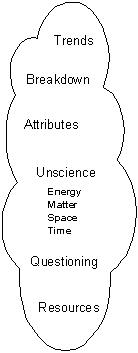12.6.6. Logic: Unscience: Matter
How To Invent (Almost)
Anything
> 12. The TAO Design Process >
12.6. The Logic Cloud
> 12.6.6. Unscience: Matter
< Prev Chapter |
Next Chapter >
< Prev Page |
Next
Page >
With simple science and unscience approach, you can think about matter and how
you can use it in innovative ways.

Fig. 12.6 The logic cloud
Matter, or material, is things of all sort, sizes and types. Think of the parts
in your problem and how matter may be used:
- Atomic effects. What is happening to the atoms and molecules? How
are they fitting with one another? How do they move relative to one another?
What bonding is there?
- Reactions. What chemical reactions are happening? What are the
effects of oxidation or decay? How are different materials reacting with one
another? How is the environment affecting things? How could you change the
environment to be more inert?
- State. Matter can be solid, liquid or gas. How can each of these
be used? How can they be converted between states? What happens when they
do? Can you solidify around things to encase them? What are the effects of
expansion and contraction? Can you replace one with another?
- Composition. Is just one material used? Could you use similar or
different materials? Could you use composite materials? How would this
change things? How can you mix materials? Layering? Blending? Alloys?
- Density. What is the density? What is the weight? Can you use a
lighter or heavier material? Can you put holes in it?
- Quantity. What if you used more or less? How about much more?
Would over-doing it produce new and interesting effects? What is ‘just
enough’?
- Rigidity. Does anything change shape? How? When? Would it help if
it did? In what way? What does it take to change the shape? Does it take
even pressure? Are there any weak spots? Do things bend or break? What
happens when you press, prod or hit various parts? Do flexible things regain
their original shape?
- Flexibility. Having flexibility allows us to manage the shape of
an object for greater effect or may have protective properties that the main
object does not have. Thin membranes can bend and be shaped to fit other
things. Ductile substances can be stretched into long fibres or wires.
Malleable materials can be shaped.
- Porosity. Having a porous object may make it lighter. Porosity
implies holes and space, which may be left open or filled with a useful
substance.
- Erosion. How do things wear? What are the effects of friction? Of oxidisation?
Of sunlight? What about the lifetime of individual parts? Could you have things
that wear out just as you are finishing using them?
Other dimensions of unscience:
Other sections in this chapter are:
< Prev Chapter |
Next Chapter >
< Prev Page |
Next
Page >
|